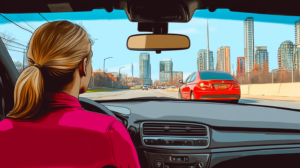Understanding the G1 Test Signs
More help for you
If you want to get your driver’s licence quickly, you must dedicate yourself to studying and preparing for each exam. The first official test will assess your theoretical knowledge of traffic signs and road rules.
While you have unlimited retake attempts if you fail the test, our goal is to help you pass it on the first try. That’s why g1.ca provides essential resources to boost your learning journey and help you become a better driver.
Half the G1 written exam focuses on road signs, so let’s explore them in detail.
How Important Are Road Signs?
Road signs are all around us, and you’ve likely already noticed some of them. Whether you’re walking outside, taking a bus or riding as a passenger in a car, they draw your attention. Up until now, you didn’t consider them very important. But as you start the process of becoming a licensed driver, it’s essential that you understand their meanings.
The G1 written knowledge test consists of 40 multiple-choice questions in total. 20 of them are dedicated to these traffic signs while the other 20 cover road rules. To pass, you must correctly answer at least 16 questions in each category.
During the written test, you’ll encounter questions featuring images of signs. You’ll need to select the answer that best explains their meaning and purpose. To remember them easily, note that traffic signs are categorized into four main types: regulatory signs, warning signs, temporary condition (construction) signs and informational signs. You can readily identify the category of a sign by its colour and shape. For the test, be sure to memorize which colours and shapes are associated with each category of sign.
It’s crucial that you understand the differences between them. To test your knowledge, there’s a free G1 test you can practice on. It includes 20 questions about traffic signs, just like in the official exam.
Regulatory Signs
Regulatory signs inform drivers of the rules that must be followed. It is an offence to disregard or disobey any of these signs. Generally, these signs have simple designs, making them easy to recognize. Here are some examples:
- Stop Sign: One of the most recognizable signs, it tells drivers to come to a complete stop at an intersection. It has an octagonal (eight-sided) shape with a red background and the word “STOP” displayed in white letters in the centre.
- Yield Sign: An inverted triangle with a red border and white interior. This sign indicates that drivers must slow down and yield the right of way to other traffic before proceeding.
- Speed Limit Sign: Rectangular in shape with a white background and a black border, this sign displays the speed limit in bold numbers at its centre. It indicates the maximum speed in kilometres per hour, which all drivers must follow.
- No Entry Sign: Often found at the entrances of one-way streets, this circular sign with a red background and a white horizontal bar across the middle prohibits drivers from entering the road ahead.
- One Way Sign: Whether it is square-shaped or rectangular, you’ll know the purpose of this sign from the words “ONE WAY” displayed in bold letters. It marks the start of a one-way street, where traffic is allowed to travel only in the direction of the arrow.
- Permissive Sign: This type of regulatory sign features a green circle on a white background. It means you are allowed to perform the activity depicted inside the circle.
- Prohibitory Sign: This type of regulatory sign features a red circle and red slash on a white background. It means that you are not allowed to perform the activity depicted inside the circle.
Warning Signs
Warning signs indicate potential hazards or changes in road conditions ahead. They provide information that is critical not only to drivers but also to pedestrians. Most warning signs are rectangular or diamond-shaped with a yellow background. The most well-known ones are:
- Pedestrian Crossing: In addition to the road markings, this sign ensures that drivers are aware of a nearby pedestrian crossing. It is diamond-shaped with a yellow background, and it has a silhouette of a person walking at its centre.
- School Zone: This sign is pentagonal (five-sided), featuring a silhouette of two children walking on a fluorescent yellow-green background. It warns drivers that they are approaching a school area where the speed limit is reduced and extra caution is needed.
- Curve Ahead: Indicating a bend in the road, this sign warns drivers to slow down in order to safely navigate the curve. It is diamond-shaped with a yellow background, and it has a black arrow that curves in the direction of the road.
- Animal Crossing: Featuring the same diamond shape with a yellow background, this sign has a silhouette of the type of animal that may be crossing the road. It alerts drivers to this hazard so they can slow down and be vigilant.
Temporary Condition (Construction) Signs
These signs inform drivers of various temporary conditions, usually involving maintenance or construction on or near the road. These signs have an orange background and are rectangular or diamond-shaped. Such signs may indicate the type of work being performed or warn drivers to slow down, change lanes, or take a detour. Here are some examples:
- Lane Closed Sign: Posted on multi-lane roadways, this sign warns that the rightmost (or leftmost) lane is closed ahead. Drivers in that lane should prepare to merge into an adjacent lane.
- Road Work Sign: This sign depicts a figure working on the ground. It indicates a work crew ahead.
- Survey Crew Sign: This sign depicts a figure looking through an instrument. It indicates a survey crew ahead.
- Traffic Control Person Sign: This sign depicts a figure holding up a sign on a pole. It means there is a traffic control person (flagperson or flagger) ahead. These workers have the authority to direct traffic, so drivers must follow their directions.
Informational Signs
Informational signs provide guidance about routes and services available to drivers. They are typically rectangular with a blue or green background and white symbols or letters. Here are some common examples:
- Highway Route Marker: Indicates the route number and direction of a highway, helping drivers navigate to their destination. They are easily recognizable by their unique shield shape featuring a small crown on top.
- Highway Exit Sign: Indicates the next highway exit and often indicates the road or town that the exit leads to.
- Hospital Sign: Indicates a hospital nearby, providing crucial information in case of medical emergencies. It has a simple design in a rectangular shape, featuring a white letter “H” on a blue background.
- Gas Station Sign: Indicates a gas station nearby, ensuring drivers can refuel when needed. It looks similar to the hospital sign but features a white gas pump symbol in the centre.
- Rest Area Sign: Rectangular in shape with a blue background and an additional text indicating “Rest Area”, this sign is placed along the highway. It informs drivers of rest areas, where they can stop for breaks and use restroom facilities.
- Dynamic Message Sign: This is a rectangular electronic sign in which the text is displayed dynamically in lights or LED displays. The messages on these signs can change throughout the day to inform drivers of imminent weather hazards, traffic jams or road closures ahead, or just to remind them to drive carefully.



